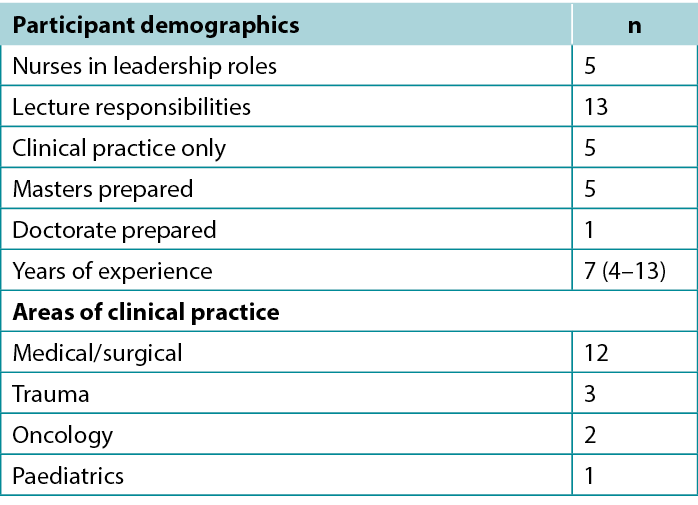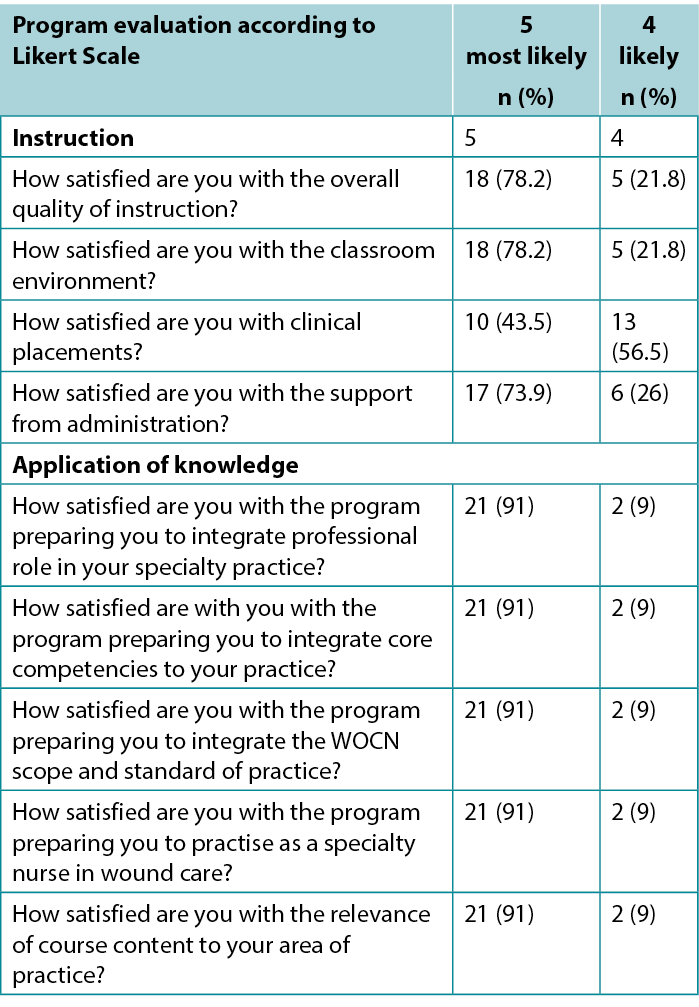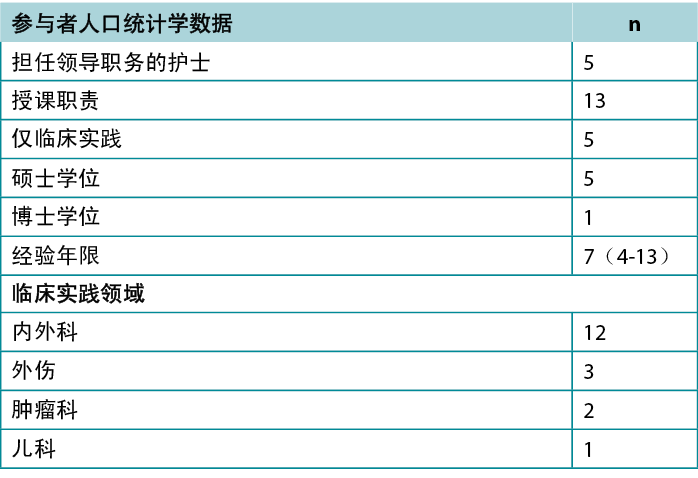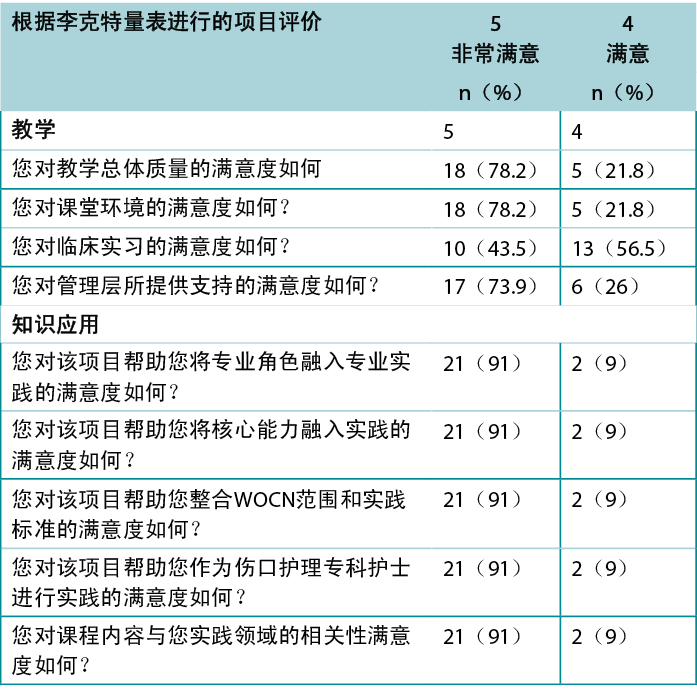Volume 43 Number 3
International WOCNEP at Ho Chi Minh University School of Nursing and the University Medical Center
Charleen Singh, Ann Nguyen, Tran Thuy Khanh Linh, Nguyen Thi Hong Minh, Fadime Koyunc
Keywords collaboration, program development, WOC nursing, WOC education
For referencing Singh C et al. International WOCNEP at Ho Chi Minh University School of Nursing and the University Medical Center. WCET® Journal 2023;43(3):13-17.
DOI
https://doi.org/10.33235/wcet.43.3.13-17
Submitted 26 August 2022
Accepted 29 April 2023
Abstract
Background Healthcare systems across the globe are challenged to meet the increasing demands for wound, ostomy and continence related nursing care.
Program development Faculty at Ho Chi Minh University of Medicine and Pharmacy School of Nursing and at the University Medical Center identified an opportunity to provide advanced wound, ostomy and continence education to nurses in Vietnam and throughout Asia. Nursing leaders chose to develop a program that met the accreditation of the wound ostomy continence nursing education program (WOCNEP) outlined by the WOCN Society.
Results Utilising technology, the barriers of time zones, delivery of didactic content and clinical collaboration were overcome to develop the first accredited WOCNEP program in Asia.
Introduction
Globally, over 9,000 nurses are certified in either the specialty of wound, ostomy or continence care1. However, healthcare systems across the globe face the complex reality of more people requiring care related to wound, ostomy or continence health issues2. There is a discrepancy between the number of specialty trained nurses and the number of patients needing both acute, chronic wound care as well as care related to ostomy and continence1. A wound is classified as a chronic wound when it does not heal normally and in a timely manner due to various pathological conditions, and often ‘stops’ at one point2. In recent years chronic wounds have become an international public health problem due to high incidence rates all over the world3. The prevalence of chronic wounds is cited at 1.5–5% in the UK4 and 1.7% in China5; Germany has a similar rate and the number increases every year6. Chronic wounds affect approximately 8.2 million Medicare beneficiaries in the United States7. The number of people with ostomy and continence concerns is also increasing globally, with approximately 1.5 million individuals possibly benefiting from specialised care8.
There is therefore an ongoing need for access to the specialty training of wound, ostomy and continence nursing1. Across the globe there are several wound care training programs and societies for nurses. However, there are few programs which focus on the trispecialty education addressing the specialty of wound, ostomy and continence. Currently the wound, ostomy, continence care nursing program developed in the late 1950s by Dr. Rupert Turnbull and former patient Norma Gill remains the gold standard for providing education and training. Together they initiated a formal education program in 1961 with the vision of developing specialised nursing care to meet the needs of populations with bowel or urinary health concerns9. The organisation then expanded its perspective to wound and continence to become the American Association of Enterostomal Therapists and in 1968 became known as the Wound Ostomy and Continence Nurses (WOCN) Society1. The society provides opportunities for specialist healthcare services to individuals with wound, ostomy or continence health related concerns. Eight training programs credentialled by the WOCN Society are in existence and all are located within the US9.
Program Development
Analysis
A wound ostomy continence nurse education program (WOCNEP) is out of reach for many nurses outside of the US and especially in Central Asia and developing countries. The cost of programs, access to didactic training, training materials and limited clinical sites, as well as language, were identified at first as barriers and then identified as opportunities. Building a program in Central Asia overcomes the barrier of cost of education, access to theory material, clinical site and language10,11. Identifying ways to share nursing speciality knowledge and experience internationally is a daunting challenge; however, utilisation of technology helps bridge the gap.
We approached each barrier as an opportunity and worked towards a feasible solution. Working closely with the WOCN Society Accreditation Committee, the first step was a feasibility study to determine if the current infrastructure for nursing education in Vietnam supports the rigorous WOCNEP. After establishing that Vietnam’s current nursing education and practice infrastructure was adequate, the program build started. The program development followed the blueprint provided by the WOCNEP Accreditation Committee on request. The feasibility phase determine the infrastructure to support WOCNEP.
The feasibility phase not only identified the ground work of nursing scholars and clinicians throughout Vietnam, but the equity technology has to offer. There is a rich infrastructure for the profession of wound care, ostomy and continence care in Vietnam. The Vietnam Wound Management Association hosts annual conferences bringing scholars from around the world to discuss the concerns of patient outcomes related to the specialty of wound care. Nurse leaders across the country recognise the value and impact of evidence-based wound care education as part of a continuing education curriculum12–16. Since 2012 nursing scholars have explored how to incorporate speciality wound care education into ongoing nursing education across Vietnam12. The Ministry of Health developed continuing professional development (CPD) curriculum based on Vietnam’s Basic Nursing Competency Standards (VNBNCS) which incorporate wound care education12-16. Initial findings from implementing a CPD program focused on wound care including increased nursing confidence in managing wounds12–16. Nursing scholars and clinicians further identified that nurses want a common language for wounds17–21. However, there is a lack of nursing specialty education addressing ostomy and continence. The WOCNEP curriculum addresses wound, ostomy and continence nursing specialty knowledge which meets the educational needs of the nurses. While no formal survey was conducted to evaluate nurses’ interest in specialty training, anecdotally nursing leaders reported a growing need based on acute care hospital patient case mix and that, if the program were available, nurses would participate.
Design
Having faith in the nursing leaders of Vietnam, the International WOC nursing education program design build started after establishing adult learning theory as the foundation of the program. Adult learning theory, developed by Knowles, is based on the idea that the adult and pre-adult learner are different from each other22,23. According to this theory, the need to know and learn are the basic components that increase the learning motivation of adult learners22,23. In this context, learners’ experiences are actually the most powerful source that motivates adult learners to learn22,23. The program design required close collaboration between the experienced WOCNEP faculty from the US, the University Medical Center of Ho Chi Minh, the Ho Chi Minh University School of Nursing, the Ministry of Health and the WOCNEP Accreditation Committee.
A design which facilitates international time zones, distance learning and supports adult learner theory was chosen. The final design of the program is 40 hours of didactic for each specialty – wound, ostomy and continence – for a total of 120 hours of theory. Didactic material is delivered over 16 weeks in English and then Vietnamese for the first cohort using video teleconferencing technology. The required 40 hours of theory is supplemented with 40 hours of case studies, small workshops and professional development over 16 weeks for each specialty, which is beyond the accreditation requirements. The supplemental 40 hours of case studies and 16 hours of simulation allow for assimilation of knowledge through increased exposure to content. Required course content is spread out over several months to provide the learner with the opportunity to assimilate new knowledge. Each session is recorded and made available for the student to review. Didactic content is presented in English and Vietnamese to facilitate focusing on content and not translation. Concepts are initially presented in English, then translated to Vietnamese as a repeat lecture with a case study.
At the end of the didactic material and prior to the start of the clinical practice portion there are 16 hours dedicated to simulation, standardised patients and case review. Each nurse is signed off as demonstrating competencies as outlined by the WOCNEP blueprint. After successful completion of competencies, the students move onto 40 hours of clinical practice with the program director. Throughout the entire instruction period the program director and lead faculty are accompanied by faculty from Ho Chi Minh University School of Nursing to ensure appropriate transfer and application of speciality of nursing knowledge and to overcome the language barrier.
The International WOCNEP is different from nursing wound education programs around the globe in that the curriculum covers the three specialities which include wound, ostomy and continence. While nurses enrolling in an International WOCNEP can chose one specialty or all three, all three is strongly encouraged.
Development
Program development began in late 2019 with a proposed start date of September 2020. However, the pandemic brought the program development to a halt. The uncertainty of the pandemic’s impact around the globe jeopardised the feasibility of the program. It was unclear if there would be enough resources left to launch a program as the first, second and third waves of the pandemic raged on.
Given the program director and lead faculty are located in the US, the burden of the pandemic was deeply felt; however, the well managed pandemic in Vietnam allowed the nursing leadership to envision how the program could flourish despite the pandemic. The current program director has experience as co-director from the established wound ostomy program at San Jose State University Valley Foundation School of Nursing. The program continued to develop with the nursing leadership from University Medical Center of Ho Chi Minh and the Ho Chi Minh University School of Nursing, encouraging the faculty in the US that this program was a beacon of hope during the grim time of the pandemic.
The development of the content followed the WOCNEP blueprint and the first cohort enrolled for a September 2021 start date. By October 2021 it became clear that, regardless of what was happening with the pandemic, the program would continue and clinical practice would take place in June 2022. The program director and lead faculty knew that during many of the scheduled lectures the nurses participating were either in lockdown, caring for extremely ill patients or dealing with the many stressors the pandemic presented. However, 24 nurses from around the southern region of Vietnam persevered to become the first cohort of International WOCNEP supported by accreditation from the WOCN Accreditation Committee.
Knowing that we were launching this program during the uncertainty of the pandemic, a clinical training location was solidified at the start of the program. It became clear that having a close relationship between a hospital and School of Nursing is an essential component. The University Medical Center of Ho Chi Minh agreed to be the primary clinical site for training to meet the required 40 hours of clinical practice for each specialty. The medical centre and School of Nursing guaranteed a clinical site contingent on faculty travelling from the US.
Implementation
The utilisation of technology facilitated the successful implementation of the wound course. Each nurse enrolled in the program was provided with an access key code to the online classroom and e-text book. The use of technology overcame the physical barriers of location and resources. Nurses tested access a week prior to the start of the course which allowed time to correct issues with classroom login and e-text book. Live lectures were delivered over video conferencing that was synchronous and recording of the lectures allowed for asynchronous instructions. Implementation of the program was supported by an educational grant to offset the cost of technology, cost of travel for clinical training, initial accreditation and resources for clinical training. The program director and lead faculty volunteered their time and expertise. Accreditation occurred with a virtual site visit and virtual presentations, and the certification board conducted an onsite visit to verify the School’s ability to be a test centre for the board certification exam of the trispecialty.
Evaluation
At the end of the first cohort of nurses enrolled in the wound course, the Ho Chi Minh University School of Nursing International WOCNEP received full accreditation for the trispecialty of wound, ostomy and continence. The evaluation included criteria outlined by the WOCN Accreditation Committee and the School of Nursing, and elements identified as important to the program director. The program director felt strongly that nurses in the cohort should comment on the inclusivity of the program by asking “did they feel this program is for them”.
Initially, 27 nurses registered for the wound course, with three withdrawing within a month of the start of the program and one nurse deferring clinical practice until 2023. A total of 23 nurses successfully completed the wound course.
The nurses in the first cohort are leaders within their organisations and had employer support to attend the course, with time off for clinical practice. A majority of the 23 nurses (n=13) in the program are lecturing faculty at either the baccalaureate or graduate level who intend to incorporate the newly learned content into their lecture material. Many (n=7) work across the age spectrum in acute care representing both surgical and medical specialities (Table 1). The nurses from acute care report being eager to develop wound care teams in their facilities and start staff education series for their nurses. Three nurses in the program are in leadership positions who intend to make systematic changes throughout the healthcare system in the management of wounds based on the evidence based practice.
Table 1. Nurses in the first cohort (n=23)

Using a 5-point Likert scale, all 23 nurses rated the program as highly likely to change their practice, and as being extremely satisfied with the delivery of the content and layout of the program. Overwhelmingly, the majority of nurses in the program voiced that they wanted more opportunities for group discussion throughout the didactic instruction. The nurses also wanted more clinical time and time to debrief after the clinical day (Table 2).
Table 2. First cohort’s evaluation of the program (n=23)

Some nurses (n=6) in the program reported feeling guilt over not knowing the wound speciality content earlier in their careers and wondered if they could have changed outcomes for their patients had they known. All nurses reported excitement in incorporating evidence-based practice into their current practice and in sitting for the board exams.
Discussion
Understanding not only the growing need for specialty nursing knowledge related to wound, ostomy and continence but the interrelationship between the trispecialty knowledge, it is important to offer all three courses. As the incidence rates of cancers that impact bowel and bladder increases year after the year, so does the need for nurses to meet humanity’s needs. Nursing is at the frontline of supporting a person back to homoeostasis in both the hospital and community setting, which implies the inherent value in the trispecialty education of wound, ostomy and continence.
The quality of life and outcomes improve when specialty trained nurses are involved in care. Literature demonstrates improved quality of life for patients with either chronic wounds, ostomy or continence related health concerns with the involvement of nurse with relevant specialty training. In the development of the International WOCNEP, the nurse leaders of Vietnam noticed the increase in patient populations within the acute care setting that would benefit from nurses having specialty training. While options for wound, ostomy and continence education are available in neighbouring countries such as Singapore and China, the programs do not facilitate the translation of knowledge to Vietnam. Other programs available within Asia offer education specific to wound care only, which do not meet the educational needs identified by the nurse leaders.
Nurse leaders of Vietnam want application of theory to their patient population, and for learning needs to be dynamic through critical analysis of current practices and theoretical application of newly acquired knowledge. Programs outside of Vietnam may not offer the same opportunity for assimilation and application of knowledge to clinical practice. It is important to change clinical practice from within current practice, making adjustment and quality improvement initiatives without disrespecting current practice. By developing a trispecialty program within Vietnam, the nurse leaders were able to identify how the specialty knowledge is applicable in the clinical setting.
Conclusion
Nurses in Vietnam who participated in the program found the International WOCNEP curriculum met their learning needs. The first cohort of the program is eligible to sit for the WOCN certification board exam. The program met accreditation requirements and is accredited by the WOCN Society Accreditation Committee for 7 years. By overcoming the barriers of language and delivery of content, there is dissemination of the specialty nursing knowledge of wound, ostomy and continence. After completing the program, the nurses from the first cohort reported confidence in delivering evidence-based wound care in their community. In developing countries where access to the wound, ostomy and continence nursing education program is limited, technology, coupled with collaboration, overcome barriers to the specialty knowledge of wound, ostomy and continence nursing education.
Ethical Clearance
Ethical clearance was obtained from Western Institutional Review Board.
Acknowledgements
We would like to thank all the nurses who participated in the first cohort.
Conflict of Interest
The authors declare no conflicts of interest.
Funding
The authors received no funding for this study.
胡志明市大学护理学院和大学医学中心的国际 WOCNEP
Charleen Singh, Ann Nguyen, Tran Thuy Khanh Linh, Nguyen Thi Hong Minh, Fadime Koyunc
DOI: https://doi.org/10.33235/wcet.43.3.13-17
背景 当前,全球医疗保健系统在满足日益増加的伤口、造口、失禁相关护理需求方面面临着严峻挑战。
项目开发 胡志明市医药大学护理学院和大学医学中心的教员为越南和整个亚洲的护士提供高级伤口、造口、失禁护理教育。护理领导者选择开发符合WOCN学会概述的伤口、造口、失禁护理教育项目(WOCNEP)认证要求的项目。
结果 利用技术,克服了时区、教学内容传授和临床合作等方面的障碍,在亚洲开发了首个经认证的WOCNEP项目。
引言
在全球范围内,超过9,000名护士获得了伤口、造口或失禁护理专业认证1。然而,全球医疗保健系统面临的现实情况仍十分复杂,即更多患者需要进行伤口、造口或失禁健康问题相关护理2。接受过专业培训的护士人数与需要进行急性、慢性伤口护理以及造口和失禁相关护理的患者人数之间存在差异1。当伤口因各种病理状态而无法正常及时愈合,且通常在某个时间点“停止”愈合时,可将其归类为慢性伤口2。近年来,慢性伤口的全球发生率较高,其已成为一个国际公共卫生问题3。在英国,慢性伤口的患病率为1.5%-5%4,而在中国为1.7%5;徳国的患病率相似,且患者人数逐年増加6。在美国,慢性伤口对约820万医疗保险受益人产生了影响7。全球饱受造口和失禁问题困扰的患者人数也在増加,约150万人可能从专业护理中获益8。
因此,目前仍需要提供伤口、造口和失禁护理相关的专业培训1。全球范围内,设立了多个伤口护理培训项目和护士学会。然而,关注与伤口、造口、失禁专业相关的三项专业教育的项目较少。目前,Rupert Turnbull博士和前患者Norma Gill在20世纪50年代末开发的伤口、造口、失禁护理项目仍然是提供教育和培训的金标准。1961年,他们秉承发展专业护理的愿景,共同发起了一项正式教育项目,以满足存在肠道或泌尿系统健康问题的人群的需求9。随后,该组织将目光延伸至伤口和失禁,发展为美国肠造口治疗师协会,并在1968年成为伤口、造口、失禁专科护士(WOCN)学会1。该学会为存在伤口、造口或失禁健康相关问题的患者提供接受专业医疗保健服务的机会。目前有八项经WOCN学会认证的培训项目,均在美国境内开展9。
项目开发
分析
美国以外,尤其是中亚和发展中国家的许多护士无法参与伤口、造口、失禁专科护士教育项目(WOCNEP)。最初,认为项目成本、获得教学培训的途径、培训材料和有限的临床研究中心以及语言均为障碍,后来又认为其也是机遇。在中亚建立项目克服了教育成本、获得理论材料的途径、临床研究中心和语言的障碍10, 11。确定在国际范围内分享护理专业知识和经验的方法是一项艰巨的挑战;不过,可以利用技术来缩小差距。
我们将每一个障碍都视为机遇,并努力寻找可行的解决方案。我们与WOCN学会认证委员会密切合作,进行了第一步行动Å\Å\开展可行性研究,以确定越南目前的护理教育基础设施是否支持严格的WOCNEP。在确定目前越南有足够的护理教育和实践基础设施后,开始建立项目。项目开发遵循WOCNEP认证委员会应要求提供的蓝图。在可行性研究阶段确定了支持WOCNEP的基础设施。
不仅在可行性研究阶段确定了整个越南护理学者和临床医生的基础工作,而且还确定了必须提供的股权技术。越南可供伤口护理、造口和失禁护理专业使用的基础设施十分充足。越南伤口管理协会每年举行一次会议,汇集来自世界各地的学者,讨论与伤口护理专业相关的患者结局问题。全国的护士领导者均认识到循证伤口护理教育作为继续教育课程的一部分的价值和影响12–16。自2012年以来,护理学者已经探索了将专业伤口护理教育纳入越南正在进行的护理教育的方法12。卫生部根据越南基础护理能力标准(VNBNCS)制定了持续专业发展(CPD)课程,其中包括伤口护理教育12-16。实施CPD项目的初步结果侧重于伤口护理,包括増强护理人员管理伤口的信心12-16。护理学者和临床医生进一步发现,护士希望能够确定伤口相关的通用语言17–21。然而,造口和失禁护理专业教育却十分缺乏。WOCNEP课程涉及伤口、造口、失禁护理专业知识,可满足护士的教育需求。虽然尚未进行正式调查来评估护士对专业培训的兴趣,但护理领导者以非正式形式报告称,基于急症护理医院患者的病例组合,对专业培训的需求越来越大,如果可建立该项目,护士均将参与其中。
设计
出于对越南护理领导者的信任,在建立成人学习理论作为项目基础后,开始进行国际WOC护理教育项目的设计建设。成人学习理论是由诺尔斯提出,其理论基础是成人和未成年学习者之间存在不同观
点22, 23。根据这一理论,求知和学习的需求是提高成人学习者学习动机的基本组成部分22, 23。在这种情况下,学习者的经验实际上是激励成人学习者学习的最强大源泉22, 23。项目设计需要经验丰富的美国WOCNEP教员、胡志明市大学医学中心、胡志明市大学护理学院、卫生部和WOCNEP认证委员会进行密切合作。
选择了一种对国际时区和远程学习有利且支持成人学习者理论的设计。该项目最终设计为每个专
业(伤口、造口、失禁)均有40小时的教学时间,理论课程总计120小时。在16周内以英语讲授教学材料,然后使用视频会议技术以越南语为第一队列学员讲授教学材料。在16周内,除规定的40小时理论课程外,每个专业还补充有40小时病例研究、小型研讨会和专业发展课程,均高于认证要求。补充的40小时病例研究和16小时模拟练习有助于通过更多的接触内容来吸收知识。规定的课程内容分几个月讲授,为学习者提供吸收新知识的机会。每节课均会录音,供学生复习。教学内容以英语和越南语呈现,以便于重点关注内容而不是翻译。概念最初以英语呈现,然后翻译成越南语,作为带有病例研究的重复授课。
在教学材料讲授结束时和临床实践部分开始前,留有16个小时专门用于模拟练习、标准化患者和病例回顾。每名护士均签字确认其具备WOCNEP蓝图概述的能力。成功符合能力要求后,学生将在项目负责人的指导下进行40小时临床实践。在整个教学过程中,胡志明市大学护理学院的教员将全程陪同项目负责人和首席教员,以确保护理专业知识的适当传授和应用,并克服语言障碍。
国际WOCNEP与全球各地的伤口护理教育项目不同,其课程涵盖伤口、造口、失禁三个专业。参与国际WOCNEP的护士可以选择一项专业或所有三项专业,但我们强烈建议其选择所有三项专业。
开发
项目开发于2019年底开始,拟定开始日期为2020年9月。然而,项目开发因新冠肺炎疫情而停滞不前。全球疫情影响的不确定性损害了该项目的可行性。在第一波、第二波和第三波疫情肆虐之际,目前尚不清楚是否有足够的资源来启动一个项目。
鉴于项目负责人和首席教员均位于美国,他们深受疫情造成的负担困扰;然而,越南的疫情管理得当,使护理领导者能够设想如何在疫情肆虐的情况下使该项目蓬勃发展。现任项目负责人曾担任圣何塞州立大学谷基金会护理学院既定伤口造口项目的联合负责人。在胡志明市大学医学中心和胡志明市大学护理学院的护理领导者的指导下,该项目得以继续开发,并且已成为疫情严峻时期的希望灯塔,使美国教员受到鼓舞。
教学内容的开发遵循WOCNEP蓝图,第一队列将于开始日期2021年9月参与项目。截至2021年10月,十分明确的是无论疫情如何,该项目始终继续进行,并且将于2022年6月开展临床实践。项目负责人和首席教员了解,在许多计划的授课中,参与护士不是因疫情而被封锁,就是在照顾重病患者或应对疫情造成的诸多压力。然而,来自越南南部地区的24名护士坚持不懈,成为首个获得WOCN认证委员会认证支持的国际WOCNEP队列。
由于我们在疫情不确定时期启动了这个项目,所以在项目开始时就确定了临床培训地点。显然,医院和护理学院之间的密切联系是完成上述操作必不可少的组成部分。胡志明市大学医学中心同意作为培训的主要临床研究中心,以满足每个专业规定的40小时临床实践。医学中心和护理学院保证提供临床研究中心,具体情况将视美国教员而定。
实施
技术的使用促进了伤口护理课程的成功开展。参与该项目的每名护士均会获得在线课堂和电子教科书的访问密钥代码。技术的使用克服了地理位置和资源的物理障碍。护士在课程开始前一周测试了访问权限,从而有时间更正课堂登录和电子教科书方面的问题。现场授课通过视频会议同步进行,授课录音可实现异步指导。该项目的实施获得了教育补助金支持,以抵消技术、临床培训差旅费、初始认证和临床培训资源相关成本。项目负责人和首席教员自愿贡献其时间和专业知识。通过虚拟研究中心考察和虚拟演示进行认证,认证委员会还进行了现场考察,以核查学院是否有能力成为三项专业医护资格认证考试的考点。
评价
在参于伤口护理课程的首个护士队列结业时,胡志明市大学护理学院国际WOCNEP获得了伤口、造口、失禁三项专业的全面认证。评价包括WOCN认证委员会和护理学院概述的标准,以及项目负责人认为非常重要的要素。项目负责人坚定地认为,应通过询问“他们是否认为该项目为他们而开发”来获得队列中的护士对该项目包容性的评论。
最初,27名护士注册了伤口护理课程,其中三名在项目开始后一个月内退出,一名护士将临床实践推迟至2023年。共有23名护士成功完成了伤口护理课程。
第一队列中的护士是其组织内的领导者,她们在参加课程时得到了雇主的支持,并有时间进行临床实践。在参与该项目的23名护士(n=13)中,大多数均为具有学士学位或研究生水平的授课教员,他们计划将新学习的内容纳入其授课材料中。许多护士(n=7)在急症护理领域从事跨年龄段的工作,代表外科和内科专业(表1)。急症护理护士报告称,其渴望在其机构中建立伤口护理团队,并为护士开展员工教育系列活动。该项目中有三名护士担任领导职位,他们计划在循证实践的基础上,对整个医疗保健系统的伤口管理进行系统性变革。
表1.第一队列的护士(n=23)

所有23名护士均使用5点式李克特量表将该项目评定为极有可能改变其实践,并对教学内容的讲授和项目布局极为满意。绝大多数情况下,参与该项目的护士大多表示,他们希望在整个教学过程中有更多机会进行小组讨论。护士还希望有更多的临床时间和临床日后的汇报时间(表2)。
该项目中的一些护士(n=6)报告称,其对职业生涯早期不了解伤口护理专业内容感到内疚,并想知道如果他们了解这些内容,是否能够改变患者结局。所有护士均报告称,其在将循证实践纳入其当前实践和参加医护资格考试方面感到非常兴奋。
表2.第一队列的项目评价(n=23)

讨论
我们不仅认识到对伤口、造口、失禁相关专业护理知识的需求日益増长,而且还了解了三项专业知识之间的相互关系,因此开设所有三类课程均非常重要。随着影响肠道和膀胱的癌症发生率逐年上升,需要更多的护士来满足患者需求。无论是在医院还是社区环境中,护理工作均处于帮助患者恢复体内平衡的第一线,这意味着伤口、造口、失禁三项专业教育存在固有价值。
当受过专业培训的护士参与护理工作时,患者的生活质量和结局均会有所改善。文献证实,在受过相关专业培训的护士的参与下,存在慢性伤口、造口或失禁相关健康问题患者的生活质量会有所改善。在国际WOCNEP的发展过程中,越南的护士领导者注意到急症护理环境中患者人群有所増加,其将受益于受过专业培训的护士。虽然新加坡和中国等邻国也提供伤口、造口、失禁教育,但这些项目并不会促进将知识传入越南。亚洲范围内的其他可用项目仅提供伤口护理特定教育,无法满足护士领导者确定的教育需求。
越南的护士领导者希望将理论应用于他们的患者人群,并通过对当前实践的批判性分析和对新获得知识的理论应用来进行动态学习。越南以外的项目可能无法提供相同的吸收知识并将其应用于临床实践的机会。重要的是,要从当前的实践中改变临床实践,在不轻视当前实践的情况下做出调整并提出质量改进倡议。通过在越南开发三项专业项目,护士领导者能够确定在临床环境中正确运用专业知识的方法。
结论
参与该项目的越南护士认为,国际WOCNEP课程满足了他们的学习需求。该项目的第一队列有资格参加WOCN认证委员会考试。该项目符合认证要求,并获得了为期7年的WOCN学会认证委员会认证。通过克服语言和教学内容传授方面的障碍,伤口、造口、失禁专业护理知识得以传播。完成该项目后,来自第一队列的护士报告成,其有信心在其社区提供循证伤口护理教育。在发展中国家,伤口、造口、失禁护理教育项目的覆盖面有限,通过技术与合作,可以克服伤口、造口、失禁护理专业知识教育方面的障碍。
伦理批准
获得了西方机构审查委员会的伦理批准。
致谢
我们要对所有参与第一队列研究的护士表示感谢。
利益冲突声明
作者声明无利益冲突。
资助
作者未因该项研究收到任何资助。
Author(s)
Charleen Singh*
PhD MBA MSN FNP-BC CWOCN RN UC Davis BIMSON
Wound Care Services, Regional Medical Center of San Jose, San Jose, CA, USA
Surgery Nurse Practitioner, Cottage Hospital, Santa Barbara, CA, USA
Program Director International Wound Ostomy Continence Nursing Education Program (WOCNEP)
Email cdsingh@ucdavis.edu
Ann Nguyen
Wound Care Services, Regional Medical Center of San Jose, San Jose, CA, USA
Program Director International WOCNEP
Tran Thuy Khanh Linh
Vice Dean of Nursing, Ho Chi Minh University of Medicine and Pharmacy, Vietnam
Facilitator International WOCNEP
Nguyen Thi Hong Minh
Chief Nurse, University Medical Center, Ho Chi Minh, Vietnam
Facilitator International WOCNEP
Fadime Koyunc
Research Assistant, University of Health Sciences Gulhane, Ankara, Turkey
* Corresponding author
References
- Wound, Ostomy and Continence Nursing Society. About us; n.d. [cited 2022 Jun 27]. Available from: https://www.wocncb.org/about-us.
- Armstrong DG, Meyr AJ. Clinical assessment of wounds; 2021 [cited 2022 Jun 27]. Available from: www.uptodate.com/contents/clinical-assessment-of-wounds.
- Olsson M, Järbrink K, Divakar U, et al. The humanistic and economic burden of chronic wounds: a systematic review. Wound Repair Regen 2019;27(1):114–125.
- Guest JF, Ayoub N, McIlwraith T, et al. Health economic burden that wounds impose on the National Health Service in the UK. BMJ Open 2015;5(12):e009283.
- Jiang Y, Huang S, Fu X, et al. Epidemiology of chronic cutaneous wounds in China. Wound Repair Regen 2011;19(2):181–188.
- Heyer K, Herberger K, Protz K, Glaeske G, Augustin M. Epidemiology of chronic wounds in Germany: analysis of statutory health insurance data. Wound Repair Regen 2016;24(2):434–442.
- Nussbaum SR, Carter MJ, Fife CE, et al. An economic evaluation of the impact, cost, and medicare policy implications of chronic nonhealing wounds. Value Health 2018;21(1):27–32.
- United Ostomy Associations of America. Home page; n.d. [cited 2022 Jun 27]. Available from: https://www.ostomy.org/
- Cleveland Clinic: Cleveland Clinic ET/WOC nursing history; n.d. [cited 2022 Jun 27]. Available from: www.clevelandclinicmeded.com/live/courses/2008/ETWOC08/history.htm
- Hutchison CB. Internationally inclusive science education: addressing the needs of migrants and international students in the era of globalization. In: Atwater MM, Russell M, Butler MB, editors. Multicultural science education. Dordrecht: Springer; 2014. p. 137–158.
- Gay G. Culturally responsive teaching: theory, research, and practice. New York: Teachers College Press; 2018.
- Dung PT, Trang LT, Tung HH. Nurses’ knowledge, practice, and confidence after the training program on wound care at the Agriculture General Hospital in Vietnam. Open J Nurs 2020;10:646–656. doi:10.4236/ojn.2020.106045
- Phan TD, et al. Assessment of knowledge, attitude, and practice of wound care among nurses based on nursing competencies standards and some related factors. J Vietnam Assoc Orthodont 2014;368–373.
- Phan TD, et al. Effectiveness of training programme on nurses’ wound care competencies after one year of implementation. Thai J Surg 2017;38:140–146.
- Phan TD, Nguyen DC. Assessment of nurses’ knowledge after 6, 9, 12 months after the training program on wound care based on nursing competencies standards at Viet Duc Hospital. J Disaster Med Burn Inj 2018;4:47–54.
- Phan TD, et al. Evaluating a training programme at Viet Duc University Hospital in Vietnam. Br J Nurs 2016;25:S14-S21.
- Do HTT, Edwards H & Finlayson K. (2023). Surgical wound assessment tool: Construct validity and inter-rater reliability of a tool designed for nurses. Journal of clinical nursing, 32(1-2), 83–95. https://doi.org/10.1111/jocn.16476
- Do HTT, Edwards H & Finlayson K. Development of a surgical wound assessment tool to measure healing and risk factors for delayed wound healing in Vietnam: a Delphi process. J Wound Care 2022;31(5):446–458.
- Do HTT, Edwards H & Finlayson K. Postoperative wound assessment documentation and acute care nurses’ perception of factors impacting wound documentation: a mixed methods study. Int J Clin Pract 2021;75(2):e13668.
- Do HTT, Finlayson K & Edwards H. Surgical wound assessment in Vietnam: a think-aloud technique and interview analysis. J Wound Care 2020;29(Sup4):S4–S13.
- Do HTT, Edwards H & Finlayson K. Identifying relationships between symptom clusters and quality of life in adults with chronic mixed venous and arterial leg ulcers. Int Wound J 2016;13(5):904–911.
- Merriam SB, Bierema LL. Adult learning: linking theory and practice 1st ed. San Francisco, CA; Jossey-Bass; 2014.
- Knowles MS, Holton EF, Swanson RA. The adult learner: the definitive classic in adult education and human resource development. 6th ed. Burlington, MA: Elsevier; 2005.


